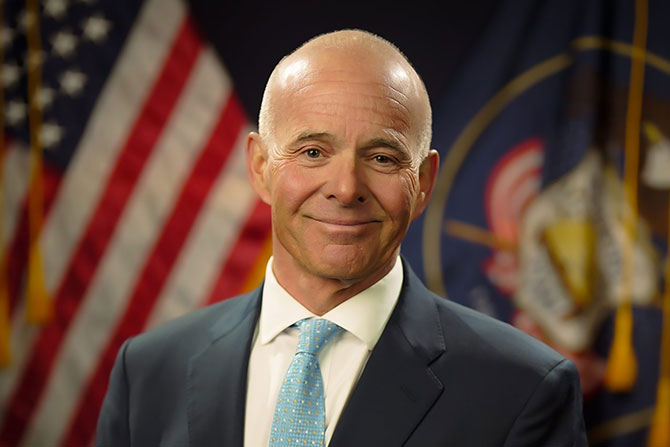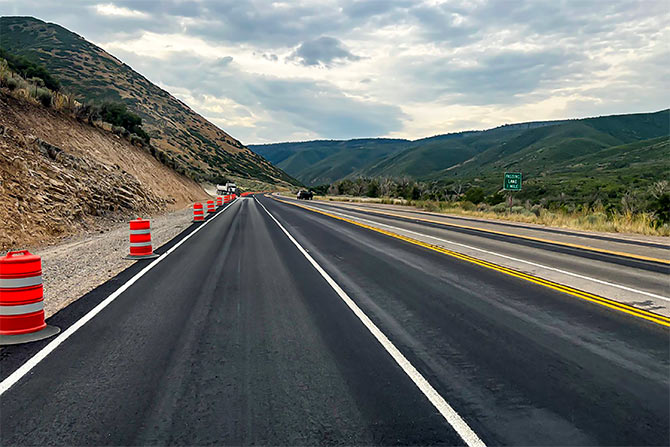 Carlos Braceras serves as the executive director of the Utah Department of Transportation (UDOT) and has since 2013. Carlos’ goal with UDOT is to ensure that innovation is encouraged and employees are empowered to offer up new ideas that will ultimately improve safety on Utah roads.
Carlos Braceras serves as the executive director of the Utah Department of Transportation (UDOT) and has since 2013. Carlos’ goal with UDOT is to ensure that innovation is encouraged and employees are empowered to offer up new ideas that will ultimately improve safety on Utah roads.
We had the opportunity to speak with Carlos Braceras and get his thoughts on important topics related to roadway safety. The following are excerpts from the conversation.
What, in your opinion, are the most significant safety challenges in Utah and how is your department addressing them?
Utah is a large state and is growing rapidly. Deciding which course of action to prioritize with the limited resources that we have is quite the decision. We are using data analytics to project where those future needs will be.
In rural areas, a specific challenge is run-off-the-road incidents. For more than 15 years we have been installing rumble strips on the rural roads to address this concern. Rumble strips placed in the center lane are intended to prevent the head-on collisions that occur on the winding, two-lane roads with speeding cars. Urban areas need attention at at-grade intersections and situations where right-angle crashes occur from red light running.
Another challenge on our radar is providing safe facilities for active transportation, such as walking or biking. In 2024, funding was approved for the Utah Trail Network, which will be an active transportation system across the state. This brings up the issue of the interface of active and vehicular transportation, and we are working on ways to make that safer, such as better lighting in intersections.
What are some technological innovations that you think will improve roadway safety in Utah?
Recently, Utah won a $20 million grant from the Federal Highway Administration (FHWA) to do a major deployment of connected infrastructure across the state. In fact, we were actually the first state in the U.S. to have a fully operational connected corridor.
We also see Connected Vehicle (CV) technologies as having the potential to be as great as seatbelts and airbags in reducing fatalities.
Utah was among the first Departments of Transportation in the country to use LiDAR technology to get situational awareness at intersections in real time. LiDAR technology is able to recreate, in 3D, an entire scene with vehicle, cyclist and pedestrian movement. In the past, detection devices only allowed a view of the stop line. I am extremely optimistic about this technology. We are now able to see more that will give us a lot more to reference when implementing safety protocol.
Another major innovation we have implemented is working with other technology providers and states to create a wrong-way driver alert system for 23 of our interchanges. This system alerts drivers when they start going the wrong way on a ramp as well as the traffic operation center. In past incidents, some troopers have even heroically crashed head-on with wrong-way vehicles to stop them. One such trooper received the Silver Barrel Award for this very thing, which we give to our employees for going above and beyond.
How does Utah promote safety in work zones and for roadway workers?
We try to humanize our workers. When people get in their cars, they tend to put up a wall between them and humanity. They forget that workers behind barriers and in work zones are people — real people who are doing important work that improves lives. Promoting this humanistic approach to driving will hopefully help remind people to drive safely, especially near work zones.
In work zones, we have people slowing traffic and we use technology to alert the workers if a car comes into the zone. We also maintain a strong relationship with our Highway Patrol. They work very hard to protect our highway construction crews.
What has Utah done to reduce traffic fatalities?
In 2006, we were the first state to make a goal of zero fatalities. We focus a lot on building proper safety behaviors in young drivers. We go to every high school and spend time talking with every new driver about the behaviors that cause crashes. Every two weeks, we also devote time talking with our new employees about safety. There are many factors that go into reducing fatalities, from technology, forging partnerships and education, and we try to implement it all.
How has the Infrastructure Investment & Jobs Act (IIJA) helped Utah’s roadway safety efforts?
The federal program accounts for about 18% of our budget, and it is crucial because having a five-year bill allows us to be strategic in planning where to allocate projects that can make a difference. If we were only working with year-to-year appropriations, it would be much more challenging to plan effectively.
The IIJA represents a significant increase compared to the previous reauthorization, which has been fantastic for us. We need to focus on reauthorizing it again, and we are already working on what we would like that to entail.
A substantial amount of funding is being distributed through grants. We have secured some excellent grants that are enabling us to implement meaningful improvements. One of the highlights is the $87 million grant we received this year, which will fund local street crossings along I-15 in St. George, a rapidly growing metropolitan area that needed better local route connections. Additionally, in August, we broke ground on a $152 million project aimed at paving and significantly enhancing the safety of 54 miles of road in the Navajo Nation, which included a $48 million federal grant.
While grants can provide a quick influx of resources, they are not reliable for long-term planning, making it difficult to strategically invest. I appreciate receiving grants when they do come through, but I would prefer to see more money allocated to the formula program in the next reauthorization and less emphasis on grants.
What other essential roadway safety issues would you like to mention, and what makes them important?
I believe we need to implement more automated traffic enforcement, such as speed and red-light cameras. During the last legislative session, I attempted to generate interest in using these cameras, specifically in school zones and work zones, but was not successful.
I spent 12 years advocating for a primary seat belt law in a very conservative state, and in 2015, we finally achieved that goal. It took nearly 15 years of consistently going to the legislature, and that primary seat belt law has saved lives.
I believe we can achieve similar success with automated enforcement, provided we approach it correctly — not as a way to generate revenue, but as a means to raise awareness and improve safety on our roads.
One important lesson I’ve learned is that success doesn’t always come to the smartest individuals. Instead, it often comes to those who are persistent and refuse to give up.







